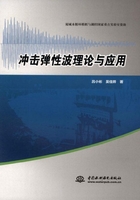
上QQ阅读APP看本书,新人免费读10天
设备和账号都新为新人
2.8 P波的频散性
如前所述,1维P波的速度为:

3维弹性体中P波的波速为:

而在薄板中传播的P波波速VP2,Love(1892)利用平面应力原理,把式(2-153)中的拉梅常数λ变更为![]() 则:
则:

显然,有VP1<VP2<VP3。当泊松比μ=0.25时,有:
因此,在弹性波中传播的P波的波速VP也有一定的频散性,当波长趋近于板厚时,VP→VP2,而波长趋近于0时,VP→VP3。也就是说,波长越长,波速越低,最大相差可达到6%。
例如,超声波测试仪激发的P波波长比锤击激发的P波波长要短,因而对弹性板的P波波速测试时,超声波仪得到的波速往往要快于冲击弹性波的测试值,其原因之一也在于此。
此外,通过简单的数学变换可知式(2-134)为:
在此,还需要注意的是,图2-34(a)中长轴方向传播P波的波速趋近于VP2,而图2-34(b)中短轴(厚度)方向传播的P波的波速则趋近于VP3。

图2-34 板中P波的传播图
同样,棒中传播的P波的波速也一样,随着波长的变长,其速度也会逐渐降低,最后趋近于VP1。反之,波长越短则趋近于VP3。
无论是超声波还是冲击弹性波,激发的信号中都有不同频率的成分。因此,在对板、棒等进行P波速度检测时,应注意是高频成分率先到达接收端。